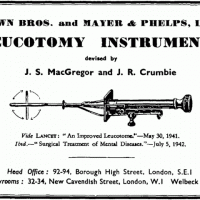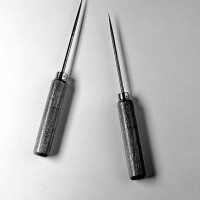
It’s not clear who first quipped “I’d rather have a bottle in front of me than a frontal lobotomy,” but it’s not just a joke. Almost anything would be preferable to a frontal lobotomy. It was a barbarous procedure with catastrophic consequences, and yet it was once widely accepted and even earned a Portuguese doctor a Nobel Prize. In the annals of medical history, it stands out as one of medicine’s biggest mistakes and an example of how disastrously things can go wrong when a treatment is put into widespread use before it has been adequately tested.
A new book by Janet Sternburg, White Matter: A Memoir of Family and Medicine, puts a human face on the suffering of mentally ill patients and their families, and helps us understand why they agreed to lobotomies. It is the affecting story of how her relatives made the difficult but misinformed decision to lobotomize two of her mother’s five siblings, one for schizophrenia and the other for depression, and the consequences of that decision.
She says “even as a child I had a slight awareness, compounded from fear and pity, that something wrong had been done, that it couldn’t be right for people to be this way, expressionless and indifferent to anything around them.” As an adult, she questioned how good, kind people like her aunts could have done this to their siblings, and how they could have authorized a lobotomy on a second family member after they had seen its effects on the first. She did extensive research, interviewed family members, and tried to understand what had happened. She was shocked when her one surviving aunt denied that Sternburg’s uncle was ever mentally ill, claiming the other sisters had lied about him when they had told the author he had tried to kill people, and that he would have grown out of it if they hadn’t insisted on the surgery. The family was dysfunctional; other members had mental health problems, and there was animosity between the sisters. What had really happened? The truth proved elusive.
As best the author could piece the story together, her uncle Bennie developed schizophrenia as a teenager and became a danger to his family, attacking his sisters with knives and anything else that might serve as a weapon. He was properly diagnosed, but every time he was locked up in an asylum, his mother literally howled in protest at the conditions, rescued him, and took him home…until the next time he tried to kill someone and had to be locked up again. His sisters lived in fear.
At the time, there was no real alternative to locking psychotic patients up; there were no anti-psychotic drugs yet. Mental illness was a stigma that made families try to hide the existence of their mentally ill members and made potential spouses hesitant to marry into a tainted family. There was a eugenics movement with the philosophy that some people didn’t deserve to live. That attitude probably made it more acceptable to experiment on patients.
The origins of frontal lobotomy

Leucotome, a tool for performing Leucotomies
Courtesy of the Bonkers Institute via the Wikimedia Commons; click to embiggen.
In 1935 a Portuguese doctor, Egas Moniz, attended a conference where he learned of an experiment where the frontal lobes of two chimpanzees were removed and they changed from violent and difficult to handle to docile and compliant. It gave him the idea that mental illness in humans might be treated surgically. He devised a leucotome, an instrument for dividing the white matter in the brain, and he experimented on 11 female patients from the Lisbon insane asylum (no informed consent in those days!). He found that they became more docile and seemingly content, just like the chimpanzees. He rushed to publish a paper proclaiming his procedure a success. Several months later, many of his patients relapsed, as did one of the chimpanzees; this follow-up information was not publicized.
An article that re-evaluated Moniz’s research pointed out numerous flaws (for instance, inaccurate description of the technical parameters, lacking angle values and variable depths of insertion).
It said:
If we believe in the summary published by Moniz of the first 20 operations, the results look promising: “35% (seven cases) healed, 35% (seven cases) improved, 30% (six cases) unchanged, no worsening, no cases of death.” [But after many more procedures had been done, a surgical mortality of 5% was reported.] Categorized according to diagnoses, of the group of 5 cases of “Mélancolie anxieuse,” 4 cases resolved and 1 improved. However, of the 7 cases of schizophrenia, only 2 improved and 5 were unchanged. Although undesirable effects arose in almost every intervention, they were only described as temporary. These were, in particular, increased temperature, vomiting, bladder and bowel incontinence, diarrhea, and ocular affections such as ptosis and nystagmus, as well as psychological effects such as apathy, akinesia, lethargy, timing and local disorientation, kleptomania, and abnormal sensations of hunger. Moniz did not admit to having detected a decrease in intelligence and memory performance, whereby it is unclear how he could have come to this conclusion.
Moniz displayed unconscionable haste, presenting his results at a conference only 4 weeks after the first operation and publishing them a few weeks later. And other doctors around the world displayed equally ill-advised haste in adopting the operation based on this very preliminary evidence.
Lobotomies flourish and Moniz wins a Nobel Prize

Watts-Freeman lobotomy instruments
Courtesy of the Wellcome Trust via the Wikimedia Commons; click to embiggen.
In 1942, Walter Freeman and a colleague wrote the book Psychosurgery: Intelligence, Emotion and Social Behavior Following Prefrontal Lobotomy for Mental Disorders. Lobotomy became increasingly popular, from 150 operations in 1945 to 2,000 in 1947. In 1949 Egas Moniz was awarded the Nobel Prize in Medicine for his discovery of lobotomy. They called it:
…one of the most important discoveries ever made in psychiatric therapy because through its use a great number of suffering people and total invalids have recovered and have been socially rehabilitated.
Bennie didn’t exactly “recover” or become “socially rehabilitated,” but the validation of lobotomy by the Nobel committee had an impact. After the award, more people were lobotomized in the three following years than in the previous fourteen years. The number of lobotomies jumped to 18,000.
Dr. Walter Freeman acknowledged that “Every patient probably loses something by this operation, some spontaneity, some sparkle, some flavor of the personality.” (An understatement if there ever was one!) But he claimed that the operation’s benefits were greater than the downsides, offering “freedom” to both patient and family. And it reduced costs: instead of the state paying $35,000 a year to keep an insane patient in an asylum, they could lobotomize him for $250 and send him home. Freeman wasn’t a surgeon, so he came up with an operation that didn’t require drilling holes in the skull or even a sterile operating room; it was simpler but even more barbaric. To put it bluntly, he stabbed the patient’s brain with an icepick through the eye socket.
Some of his colleagues were horrified by the icepick method, and they denounced it. So Freeman became his own PR agent, traveling around the country in a van he called the Lobotomobile, assaulting patients with icepicks and spreading the gospel of lobotomy like a sort of modern Johnny Appleseed. He got to the point that he could do a lobotomy in 12 minutes. Instead of anesthesia, he used an electroconvulsive shock box, even though it sometimes resulted in broken bones from convulsions.
He inflated his statistics. He called his surgeries a success if the patient could return to work, but there was a double standard. For men, work was defined as engaging in activity outside the home; for women, it was performing simple household tasks within the home. Of the 241 lobotomies carried out at Stockton State Hospital, 85% were on women.
Bennie’s operation
A psychiatrist named Myerson presented lobotomy to the Sternburg family as a way for them to keep Bennie at home. He explained that it would disconnect the signal from Bennie’s emotional centers that told him someone was dangerous, so he would no longer be violent. After much discussion, they bowed to the authority of the expert and authorized the surgery.
Here is what was done to Bennie: holes were drilled in his skull; the blade of an instrument was inserted through the holes, its handle swung as far and deep as possible.
He was no longer violent, and the family no longer had to fear him; but he didn’t speak a word, he barely moved, and he didn’t react to anything or anyone. He was incapable of taking care of himself and required constant supervision. He had eruptions of inappropriate sexual behavior with family members. He would do odd things in public like whirling on the sidewalk like a dervish in a slow trance. He even had to be reminded not to swallow food whole without chewing. After 15 years he suddenly recovered the ability to speak but then subjected the family to a surrealistic nonstop flood of fragmented thoughts. He had become “a head without the czar inside.”
Dejá vu
Later, one of the sisters, Francie, became severely depressed and even developed auditory hallucinations. She was hospitalized after a suicide attempt, but some time later she was found lying half-conscious on the streetcar tracks. Medication and electric shock treatments had been unavailing. The doctors offered an improved “mini-lobotomy” procedure that they promised would enable her to live alone and care for herself. They told her family that without the surgery she would “weep for the rest of her life.” Seeing it as a last resort, and after much agonized discussion, they agreed to the surgery.
After surgery, she could indeed live alone and care for herself, but she was reduced to a person who would phone her mother with pride to announce that she had made a TV dinner all by herself. She compulsively gulped down any pills she could find and tried to destroy the evidence of what she had done; they couldn’t tell whether she was trying to kill herself or not. She was apathetic and unreactive. Like Bennie, she had been “erased” and turned into a sort of zombie. She had not wanted the operation, but after it was done she never even mentioned it.
Lobotomy is discredited
Bennie died at the age of 59 in a nursing home. He had been twirling in the hallway until an attendant turned him toward the dining room for lunch. At lunch, he tried to swallow a handful of peanuts all at once and choked to death. That same year, Walter Freeman performed a third lobotomy on one of his earliest patients who had relapsed for the second time. He tore a blood vessel in her brain and she hemorrhaged to death. His surgical privileges were taken away.
There was an increasing backlash against lobotomy, with publicity about prominent victims like JFK’s sister Rosemary, described as “just a bit slow, a bit difficult.” She came out of her lobotomy permanently disabled, paralyzed on one side, incontinent, and unable to speak coherently. She required constant care by a private nurse for the rest of her life. Lobotomy began to be perceived as an inappropriate means of social control. The movie One Flew Over the Cuckoo’s Nest became a classic. Lawsuits were filed. Legislation was enacted against it in various states. Even though the USSR was notorious for making bogus psychiatric diagnoses of political dissidents and incarcerating them in insane asylums to control them, it set an example by prohibiting lobotomies in 1950 on moral grounds. Effective antipsychotic drugs were discovered, offering a better way to handle these patients.
Is life without feeling ever acceptable?
Sternburg started her investigation with the assumption that the operation turned everyone into zombies, but she learned otherwise: “[It] sometimes provided genuine relief to people who, to my surprise, were able to be aware of their situations, even to compare them with the past and say how much better they were. One trade-off, though, remained constant: the lobotomized remained indifferent.” She describes Bennie as “a person at the farthest reaches of not being at home in the world, in the midst of a tribe that had damaged him and also kept him safe.”
That raises serious philosophical and ethical questions. Is a life without feeling preferable to one spent in torment? Who is to decide? Can psychotic patients give informed consent? In a modern world concerned about terrorism, “the possibility of dehumanizing people is always with us, at least as great a terror.”
Conclusion: A cautionary tale we hope never to be repeated
Frontal lobotomy was one of the most regrettable chapters in the history of medicine. Sternburg’s book gives us insight into its impact on its victims and on their entire extended families. It tells a cautionary tale that we should know about and remember so that kind of thing will never happen again. Its most important lesson is the one we keep stressing on SBM: before a proposed treatment is put into widespread use it must be submitted to rigorous scientific testing to evaluate it for safety, effectiveness, and unexpected consequences.
